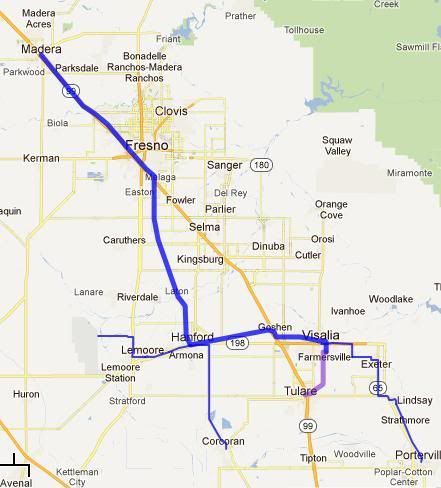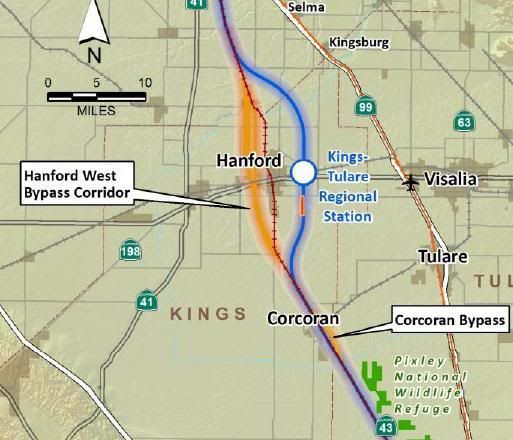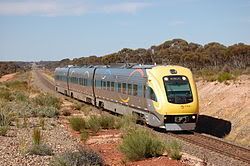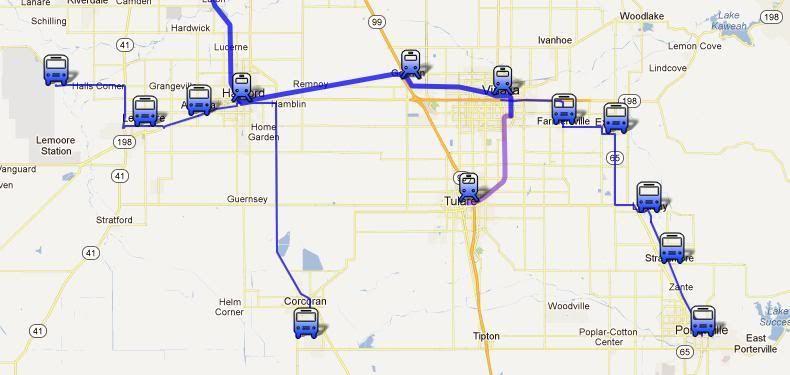(10 am. – promoted by ek hornbeck)
Burning the Midnight Oil for Living Energy Independence
 Kings County officials have been opposed all proposed routes:
Kings County officials have been opposed all proposed routes:
Board members said no high-speed rail route through Kings County would be acceptable while denouncing the Authority and its Fresno-to-Bakersfield environmental impact report.
“I think we should come out and oppose high-speed rail in Kings County, no matter what alignment they have,” said Supervisor Tony Barba during a discussion of the county’s official response to the EIR, which is due Thursday. He was applauded by a large crowd that nearly filled the Board of Supervisors’ chambers at the Kings County Government Center.
And then they opposed getting started on California HSR:
HANFORD – Kings County supervisors on Tuesday will likely ask three key legislators to delay high-speed rail funding until the project resolves local conflicts.
…
The Legislature is expected to vote in June whether to spend $2.7 billion in state bond money on the project, which has created major controversy in the San Joaquin Valley and stoked opposition from several cities and counties who believe it should be scrapped.Denying the funding would stop the Authority from starting construction in Fresno later this year or in early 2013.
And now, County officials seek to preserve Amtrak :
…
But Authority officials have recently entered into discussions with Kings County to see if Amtrak service through Hanford and Corcoran can be preserved, said Larry Spikes, Kings County administrative officer. Downtown stations are considered critical to cities’ local economy.Authority Board Chairman Dan Richard couldn’t be reached for comment.
“Taking Amtrak right out of the heart of Hanford and Corcoran is just not a good idea,” Spikes said.
So, don’t want the HSR Station in town, don’t want the HSR to go outside of town, and wants Amtrak to be continued to Hanford and Corcoran at slow speed when the San Joaquin after the high speed route between Merced and Bakersfield becomes available.
What I am looking in this week’s Sunday Train is a different way to go about this that provides a mix of local and intercity transport benefits to the major county centers: the Fresno Regional Rail Corridor.
Hey, We’ll Take It If You Don’t Want It!
One reaction to the actions of the Kings County Supervisor came from neighboring Tulare County with Visalia as its largest center. Robert Cruickshank at the California HSR Blog reported back in December that Tulare County Still Wants High Speed Rail :
Kings County leaders may have decided they’re happy with a 14.6% unemployment rate, opposing high speed rail and the long-term economic benefits it will bring to their county. But next door in Tulare County, leaders understand the benefits that high speed rail will bring – and they want in:
Watching their neighbor’s increasingly warlike stance, Tulare County, which strongly supports the project, has been looking for a way to insure the fast growing population in the two county region – nearing 1 million by 2030 – has a station. So instead of partnering up with Kings County as had been planned, they have decided to go it alone.
The city of Visalia will take up the idea at its Dec. 21 council meeting, Olmos said. “Now that we know they will be building the first leg of the route right here, we understand that it has moved up our chances to get a station. We’ve been told that if we want a station we need to apply fairly quickly.”
In this draft of a submission from Tulare, they argued:
We believe that the HST in California is a critical investment in our future. In the short-term, it provides Californians with jobs to stimulate the economy. In the long-term, the benefits are far greater. As California’s population continues to grow so will its economy, but growth also brings congestion that backs up our freeways and pollution that fills the air we breathe. California is at a point in its growth when it must take a hard look toward its horizon to discern how it will alleviate the negative consequences that growth brings and plan for a vibrant, prosperous and sustainable future.
The HST gives Californians an opportunity to gain efficiencies in how they interact with people, business and entertainment throughout the state, while also reducing the environmental impacts of transportation. California’s HST isn’t a luxury; we believe it’s a necessity. It is an efficient, environmentally sound transportation choice for California residents and visitors.
The Basic Case for a Kings/Tulare County Station
The basic case for a Kings/Tulare county station can be seen when we look at how Hanford Station performs on the San Joaquin route. These are the average of boardings and alightings per day based on total annual boarding and alighting divided by 365, to the closest 10’s:
- 570 ~ Bakersfield (terminus)
- 470 ~ Fresno
- 360 ~ Stockton,
- 260 ~ Hanford
- 160 ~ Sacramento{2}
- 130 ~ Merced
- 130 ~ Emeryville{1}
- 130 ~ Modesto
- 120 ~ Martinez{1}
- 70 ~ Oakland{1}
- 60 ~ Richmond{1}
- 40 ~ Antioch/Pittsburgh{1}
- 40 Corcoran
- 30 ~ Turlock/Denair
- 20 ~ Wasco
- {1} About 2/3 of services originate at / proceed to Oakland.
- {2} About 1/3 of services originate at / proceed to Sacramento.
 While there is no particular urban center in Kings and Tulare Counties that is large enough to necessitate an HSR station, the combined population of 1m and growing and the fact that the existing Amtrak station at Hanford already serves over a full busload of passengers per Amtrak San Joaquin service suggests it at least merits consideration.
While there is no particular urban center in Kings and Tulare Counties that is large enough to necessitate an HSR station, the combined population of 1m and growing and the fact that the existing Amtrak station at Hanford already serves over a full busload of passengers per Amtrak San Joaquin service suggests it at least merits consideration.
However, the one thing that is set in stone is that the HSR station has to be on the HSR corridor. Alignment Alternatives planning has been progressing, the CHSRA has given Hanford its wish to not have the corridor go through town, and that means that the remaining alternatives for the HSR corridor are a bypass west of town and a bypass east of town. So if the HSR corridor bypasses Hanford on the east, the HSR station can be placed on the eastern edge of Hanford, on the State Route between Hanford and Visalia, and if the HSR corridor corridor bypasses Hanford to the west, the HSR station can be placed on the western edge of Hanford.
So both Downtown Hanford and Downtown Visalia are out, as far as HSR stations go.
Going the Other Way Around
 However, now that Kings Country is saying they want to keep their downtown Amtrak Station, and that the Amtrak level of service is good enough, there is a way to keep that level of service in downtown Hanford ~ and extend it to downtown Visalia as well. And that is by running a train down from the Fresno HSR station, along the HSR corridor, then leaving the corridor at the Hanford Bypass and heading along the existing BNSF alignment to the downtown Hanford station.
However, now that Kings Country is saying they want to keep their downtown Amtrak Station, and that the Amtrak level of service is good enough, there is a way to keep that level of service in downtown Hanford ~ and extend it to downtown Visalia as well. And that is by running a train down from the Fresno HSR station, along the HSR corridor, then leaving the corridor at the Hanford Bypass and heading along the existing BNSF alignment to the downtown Hanford station.
From there, there is a freight rail corridor that runs across between the BNSF mainline and the Union Pacific Mainline next to Visalia, and then continues running through Visalia and then down to a set of Central Valley farming hamlets and towns. And connecting to that is an abandoned rail corridor between Visalia and the smaller town of Tulare.
Now, that implies running about 25 miles on the HSR corridor between Fresno and the Hanford Bypass. At 220mph that is a transit of 7 minutes, while at 80mph that is a transit of 19min. That means that an HSR train that is 12min. south of Hanford would arrive in Fresno as an 80mph train leaving Hanford station and then joining the HSR corridor.
However, you cannot run trains “bumper to bumper” at 80mph, let alone 220mph. The “headway” is the time separation that you have to leave between the “tail” of one train and the “head” of the next one. The 2008 Prop1a specifies headways of 5 minutes. So for proper leeway, HSR chasing down an 80mph train on the HSR corridor would have to be about 17 minutes south of Hanford.
Headways of 5 minutes means that the maximum “bumper to bumper traffic” capacity of the corridor is 12 trains per hour, but in intercity rail transport, that capacity is most effectively used with a mix of different stopping patterns, where part of the capacity is devoted to the faster trains catching up to the slower trains until they hit a point built to allow a timed passing move. And in this mix, a 17minute footprint for a local train running through the corridor is a concern.
How can we reduce the footprint of this local rail system on the HSR corridor? By making it faster. At 125mph, 25 miles is a transit of 12min. That is only 5 minutes longer than a train at 220mph.
That train pictured is a “Diesel Multiple Unit”, or “DMU” train, that provides the Transwa Prospector service between Perth and the mining town of Kalgoorlie, and runs at top speeds of 125mph. And that’s pretty much the kind of configuration required. Now, that is probably a bit lighter than a DMU that is FRA-approved for running in mixed operation with freight, so a decision would have to be made between getting a a time-separation agreement with the freight operator on the branch line between Hanford and Visalia, or between going for the greater weight and lower fuel efficiency of an “FRA compliant” DMU. The section of mainline BNSF corridor between the Hanford Bypass and downtown Hanford is short enough that a single express track could be laid, with agreement of the corridor owner, and available for the use of the corridor owner as an express passing track during the period that the Fresno Regional Rail Corridor (FRRC) is shut down.
Extensions to the Fresno RRC System
 Now, that express track arrangement may or may not be possible with the BNSF, the owner of the alignment through Hanford. I am still less confident that it might be possible on conventional rail corridor owned by Union Pacific, that the HSR is paralleling through Fresno. However, if it is, then the FRRC could leave the HSR corridor in Fresno, north of the HSR station, and continue for a long enough run for a following HSR train to stop in Fresno, and proceed on through. The FRRC could then reenter the HSR corridor and run through toward Madera, leaving the HSR corridor to terminate at a downtown regional rail station to replace the Amtrak station at the far north corner of town.
Now, that express track arrangement may or may not be possible with the BNSF, the owner of the alignment through Hanford. I am still less confident that it might be possible on conventional rail corridor owned by Union Pacific, that the HSR is paralleling through Fresno. However, if it is, then the FRRC could leave the HSR corridor in Fresno, north of the HSR station, and continue for a long enough run for a following HSR train to stop in Fresno, and proceed on through. The FRRC could then reenter the HSR corridor and run through toward Madera, leaving the HSR corridor to terminate at a downtown regional rail station to replace the Amtrak station at the far north corner of town.
That gives the rail corridor illustrated with the bold blue and purple lines. This is an intercity rail service, not a local commuter line, and so there are not a large number of stations: including the Madera option, it would be Madera, Fresno HSR, Hanford, Goshen, Visalia, and Tulare. Goshen, directly off of SR99, is the main Park and Ride station for the system, with the other stations focusing primarily on their country towns for their catchment. Hanford already has a bus system that is organized around the buses meeting at the Amtrak Station every thirty minutes, and a single town center station is within the reach of a neighborhood electric vehicle or bike ride of anyone in town.
 The reach of the system can be extended by supporting regional bus service, which are the narrow blue lines shown. Regional bus service runs from Hanford to both Corcoran and to the Leemore Naval Air base, the home port of the Strike Fighter Wing Pacific. Another bus line runs from the Visalia station to Porterville, and the small hamlets on the way {NB. not Pottersville ~ that’s one thing we are trying to avoid, here}.
The reach of the system can be extended by supporting regional bus service, which are the narrow blue lines shown. Regional bus service runs from Hanford to both Corcoran and to the Leemore Naval Air base, the home port of the Strike Fighter Wing Pacific. Another bus line runs from the Visalia station to Porterville, and the small hamlets on the way {NB. not Pottersville ~ that’s one thing we are trying to avoid, here}.
Note that the Regional Bus is not a local city bus service: it is an express regional connector. Also note that the routes themselves should be seen as schematic ~ I have never driven in either Kings County or Tulare County, so I have no particular on the ground knowledge of which streets are more appropriate for a high quality Regional Express Bus, and which are less effective.
Finally: Why This Is Better Than Hanford HSR Station …
{+crickets+}
I never said this is better than Hanford HSR station. Indeed, an earlier version of part of this system came from an earlier look at what might be done in Kings and Tulare Counties if they obtained an HSR station.
The benefits of this system are a single seat ride to the other main town centers in Kings/Tulare Counties, and to Fresno HSR, which will be the center of the Fresno public transport system. If you are convenient to a Fresno RRC station, the single seat ride to both the HSR station and to the center of Fresno’s transport system could well be preferable.
The benefits of the Hanford HSR station is that the HSR station is right there, which is a particular benefit to Regional Express Bus riders who get a single connection to the HSR station instead of a connection to a regional rail, which connects to HSR.
However, it stops being a trade-off between those convenient to a town-center train station and those who want a bus ride direct to the HSR station … if it turns out that Hanford can’t get an HSR at the edge of town. If that happens, then this approach seems likely to be substantially better than hopping on a bus to Fresno to catch the HSR.
Conclusions …
As always, the Sunday Train does not end with a conclusion, but with opening the floor for discussion while the headliners warm up to start their set. And, as always, the discussion is not limited to the points raised in the points at hand: if you want to raise an entirely different topic about Sustainable Transport, go ahead and launch a new comment thread.
Midnight Oil ~ Truganini

1 comments
Author
… just means they’ll run at a faster tempo …